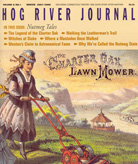(c) Connecticut Explored Inc. Winter 2007/2008
Subscribe/Buy the Issue!
I recently discovered that both my husband and I are descended from Mayflower Pilgrims John Howland and Elizabeth Tilley. What an eerie feeling it was, then, to discover that it is “by the grace of God,” as Howland himself might have said, that my husband and I both walk this earth 387 years later, for Howland fell off the Mayflower during a storm mid-voyage. Miraculously, he caught hold of a trailing halyard and was hauled back on board!
I learned of Howland’s mishap and rescue while reading Mayflower by Nathaniel Philbrick (Penguin Books, 2006) last summer, a book that has spent many weeks on the New York Times bestseller list. Before cracking the cover of Mayflower, I wondered whether the book would prove a major myth-buster: I figured the story behind Thanksgiving, of the happy gathering of English settlers and Native Americans over a meal of turkey and fixin’s, had to be more fiction than fact. Not so, Philbrick reports, “Without [Wampanoag leader] Massasoit’s help, the Pilgrims would never have survived the first year… [And] Massasoit realized …that his own fortunes were linked to those of the English. In this respect, there is a surprising amount of truth in the tired, threadbare story of the First Thanksgiving.” [Read Indian Country Today‘s story about how the Wampanoag view Thanksgiving.]
In this issue, we look at some of Connecticut’s own myths and legends. Sounds fun, and it was. But it was also tricky. To start with, we asked ourselves, “Do myths have any place in this magazine?” Webster’s dictionary defines a myth as “a traditional story of ostensibly [emphasis added]historical events that served to unfold part of the world view of a people or explain a practice, belief, or natural phenomenon.” As a history magazine, it’s important to us that our stories be based in fact. And yet the myths we create over time tell us something about our culture and who we are, and they often involve the things we’ve feared and our response to that fear. Adding to the challenge of sorting out our myths, first-hand accounts of legendary events often prove, under time’s harsh scrutiny, to be inaccurate or misleading.
Keeping one eye on veracity, then, we’ve included myth-rich stories of Colonial witch trials in
Wethersfield, the various “Washington slept here”-style claims associated with inns and taverns throughout the state, the discovery of prehistoric mastodon bones in Farmington, the appearance in the 19th century of a meteorite in Weston, the Leatherman’s peregrinations, plus a selection of the myriad objects that have drawn power and inspiration from Connecticut’s central and defining myth—the story of the Charter Oak, including a wooden nutmeg carved from its wood!
5th Anniversary Event
You’re invited on January 20, 2008 to a free reception celebrating both HRJ’s 5th anniversary and the re-opening of the Hartford History Center at Hartford Public Library. Please see Afterword [p. 53] for details.
2008 Special Edition Calendar
HRJ is once again offering a complimentary four-color wall calendar as a thank-you for renewing, subscribing for the first time, or giving a gift subscription. The calendar, supported in part by the Connecticut Commission on Culture & Tourism and our printer Wolf ColorPrint, features nine historic inns in the state and three museums. Please see Letters, etc. for details about how to get your calendar- only available through December 31, 2007 or while supplies last!
Friends of Hog River Journal
Thank you to all who responded to our fall “100 Friends of Hog River Journal” campaign to support the future of this unique nonprofit magazine celebrating Connecticut’s rich cultural heritage. There’s still time to give a tax-deductible contribution. Please send your donation to Hog River Journal, P. O. Box 271561, West Hartford, CT 06127-1561. Donors will be recognized in the spring issue.
Explore!
Read all of our stories in the Winter 2007/2008 issue
“Connecticut River Legends,” Spring 2019

